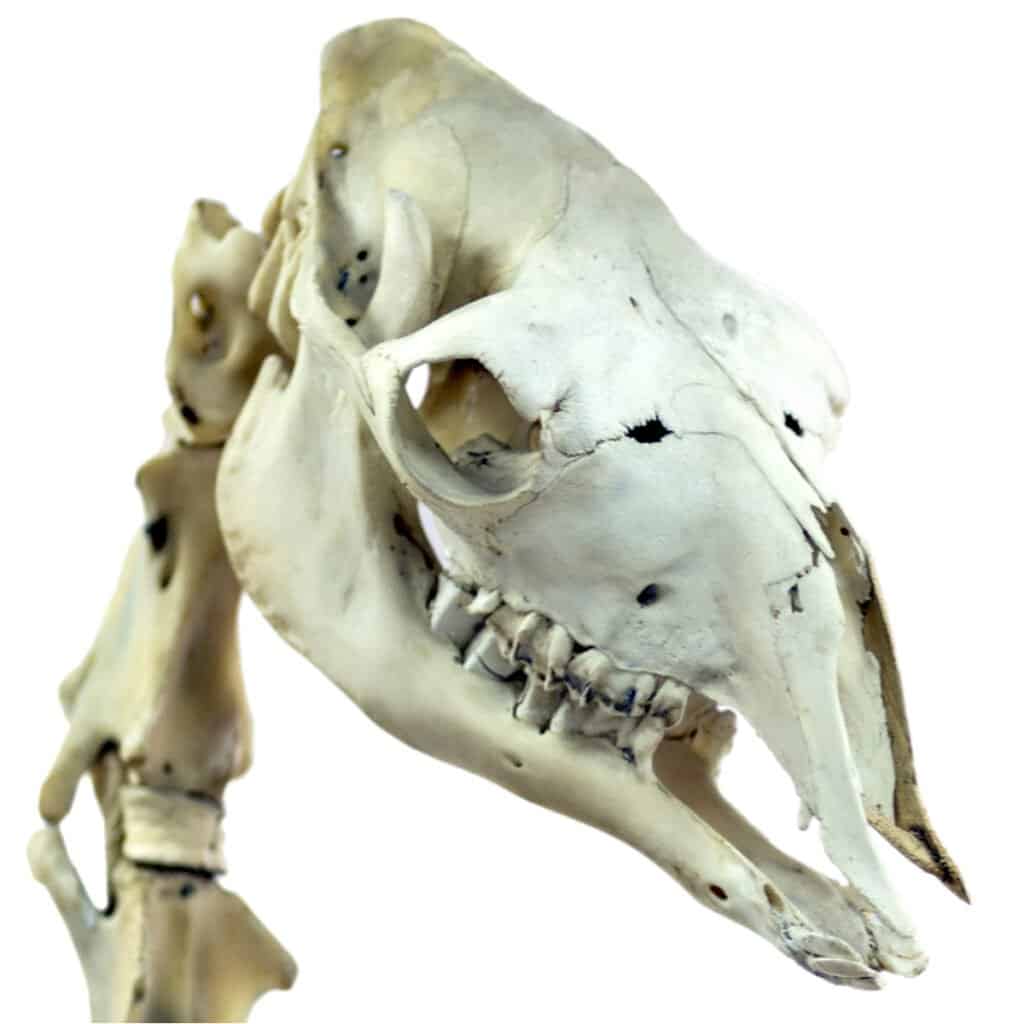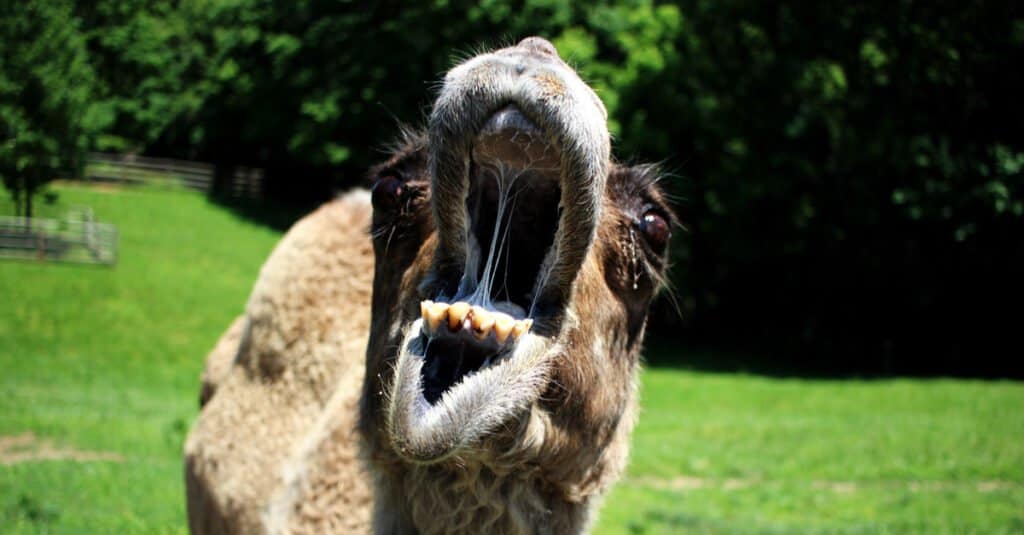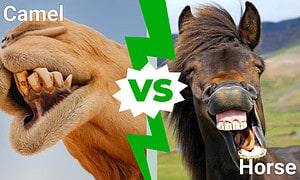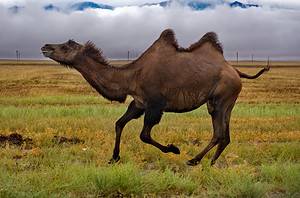
Adult camels have 34 teeth.
©Alexandra Lande/Shutterstock.com
Camels are members of the Camelidae family along with alpacas and llamas. They’ve long been domesticated for meat, milk, and transportation, and are famous for their fatty humps. Today, there are two extant species of camel; the Dromedary, and the Bactrian.
No matter what species, or where they live, all camels have the same teeth. Here, we’ll discover just how many teeth camels have, how many sets they go through, and what they use them for. Then, we’ll take a look at those fearsome canine teeth, and whether or not you should be worried about getting bitten by a camel.
Camel Milk Teeth
Camels aren’t born with any teeth. In fact, it takes nearly a month for their first teeth to erupt fully. The first teeth a camel gets are its cheek teeth (molars and premolars) and bottom incisors. Once they’re about three months old, they get their first canines (yes, camels have canines), and the rest of their cheek teeth.
By the time they’re six months old, baby camels have all their milk teeth. Camels only have 22 milk teeth, but grow more than that when their permanent teeth come in.
Camel Adult Teeth

Adult camels have 34 teeth; eight incisors, four canines, and 22 premolars and molars.
©ROMSVETNIK/Shutterstock.com
Camels keep their deciduous, or milk, teeth for a long time; they don’t start growing permanent teeth until they’re around five years old. It takes a couple of years before they have a full set of adult teeth. By the time they’re seven years old, camels have all 34 of their adult teeth.
By the time they’re 15, the adult teeth begin to wear significantly. Camels can live up to 40 years, and because their teeth wear down so fast, they spend a big portion of that long life eating with difficulty. They’re helped though by a couple of interesting parts of the camel’s mouth.
The Camel’s Mouth
First, camels have prehensile lips. This means that their lips operate a lot like human fingers, and can manipulate even the smallest of leaves. Adult camels don’t have any front teeth on the top–only a thick, fleshy pad that they use in conjunction with their bottom incisors to chew up tough food.
Second, the inside of a camel’s mouth has thick tissues called papillae, which protect the mouth from injuries. This is especially important given the camel’s predilection for eating cactus.
Incisors
Camels have eight incisors. On the bottom, they have a pair of central incisors, a pair of lateral incisors, and a pair of corner incisors close to their canines. They have no central or lateral incisors on the top, only a hard, fleshy pad. But they do have corner incisors. These incisors are conical and resemble small canine teeth.
Camels are unique among ruminants (animals with multi-chambered stomachs, like cows) in that they have maxillary (top) incisors. It’s likely that camels have these teeth, along with their canines, to help them handle the varied foods in their diet.
Canines
Camels have four canine teeth; two on top and two on bottom, with two on each side. The canines are located directly behind the incisors, towards the front of the mouth. Female camels have smaller canines than males. They’re primarily used to chew up wood and other tough foods.
Premolars
In addition to the cheek teeth, located further back in the jaw, camels have four premolars (two on each side, with two on the top and two on the bottom) that are located just behind the canine teeth. These premolars look like small canines, and are often supernumerary (present, but not useful). Female camels don’t always have these tusklike premolars. Camels have a large gap between their first and second premolars called a diastema–there are no teeth in the gap.
Molars
The final teeth in the camel’s mouth are the chewing premolars and molars, or ‘cheek teeth’. Camels have 22 total cheek teeth (including the forward premolars). The chewing teeth have high ridges for pulping up fibrous vegetation. In addition to chewing up food, camels also use their cheek teeth to chew cud–regurgitated, partially digested plant material–before swallowing it to digest again. Because camels are ruminants, and have to chew cud in order to digest, they cannot wear bits like horses, which would interfere with their constant chewing.
Do Camels Bite?

Camels will bite if provoked, adult males can cause serious injury.
©Logan Bush/Shutterstock.com
All camels have formidable teeth, but sexually mature males have especially dangerous canines. These teeth are mostly used to chew up wood and other tough substances–but in rutting males, they take on a dangerous edge.
Male camels compete with one another for mates; they use their mouths to bite and lash out at one another. Because male camels have such large canines, these fights can quickly turn bloody. Camels rarely kill each other in fights, but they do pose a risk to other creatures that get in their way–including humans.
A camel’s first instinct isn’t to bite. Instead, they will often express their annoyance or displeasure by spitting foul smelling liquid at the object of their ire. When camels do decide to bite though, the affects can be deadly.
Teeth for Defense
Camels are powerful animals, adults stand six feet tall at the shoulder. Often, when they bite humans, they grab the hand or arm and lift the person fully off the ground to shake them. These types of attacks almost always require medical attention, as the canines penetrate the skin and leave deep wounds. More rarely, camels bite the head or neck, and these injuries can be fatal.
It’s important to be extremely careful–and respectful–around camels. Don’t forget that they’ve got a mouth full of teeth, some of them sharp, and they’re not afraid to use them. If you’re bitten by a camel, seek immediate medical attention.
The photo featured at the top of this post is © Logan Bush/Shutterstock.com
Thank you for reading! Have some feedback for us? Contact the AZ Animals editorial team.







